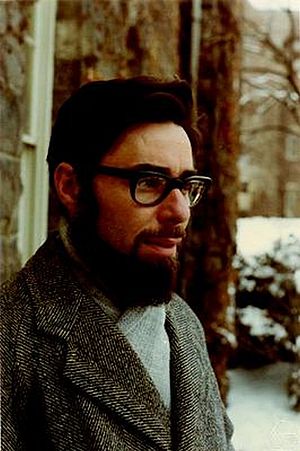Harry Kesten facts for kids
Quick facts for kids
Harry Kesten
|
|
|---|---|

Harry Kesten at Cornell University, 1970
|
|
| Born |
Harry Kesten
November 19, 1931 Duisburg, Germany
|
| Died | March 29, 2019 (aged 87) Ithaca, New York, United States
|
| Nationality | American |
| Alma mater | |
| Known for |
|
| Spouse(s) | Doraline Kesten |
| Children | 1 |
| Awards |
|
| Scientific career | |
| Fields |
|
| Institutions | |
| Thesis | Symmetric Random Walks on Groups (1958) |
| Doctoral advisor |
|
| Doctoral students | Maury Bramson |
Harry Kesten (born November 19, 1931 – died March 29, 2019) was an American mathematician. He was famous for his work in probability. This is a branch of mathematics that studies chance and randomness. He looked at how things move randomly, like on a map or in a network.
Contents
About Harry Kesten
Harry Kesten was born in Duisburg, Germany. In 1933, when he was very young, his family moved to the Netherlands. They did this to escape the Nazis, a political group that caused a lot of trouble in Germany at that time.
He later moved to the United States. In 1958, he earned his PhD degree from Cornell University. His teacher there was Mark Kac. After that, he taught at Princeton University and the Hebrew University of Jerusalem. In 1961, he came back to Cornell University.
Kesten passed away on March 29, 2019, in Ithaca. He was 87 years old.
Harry Kesten's Mathematical Discoveries
Harry Kesten made many important discoveries in the field of probability. Here are some of his key contributions:
Random Walks
Imagine a tiny bug moving randomly on a grid. This is like a "random walk." Kesten studied these walks on different kinds of networks, called groups and graphs. He figured out how likely it was for the bug to return to its starting point. He also found a special rule, now called Kesten's criterion for amenability. This rule helps mathematicians understand certain types of groups.
Self-Avoiding Walks
Think about a path that never crosses itself. This is a "self-avoiding walk." Kesten studied these paths on a grid. He found a rule that helps predict how many such paths exist as they get longer. This was a very hard problem, and his findings are still important today.
Branching Processes
Kesten also studied "branching processes." These models help us understand how populations grow or shrink. For example, how a family tree grows, or how a disease spreads. He helped figure out the conditions for these populations to grow in a predictable way.
Random Walks in Changing Environments
Imagine a bug doing a random walk, but the rules for moving change depending on where the bug is. This is a "random walk in a random environment." Kesten worked with other scientists to understand how these walks behave. They found out how the environment affects the bug's long-term journey.
Percolation Theory
One of Kesten's most famous works is in percolation theory. Imagine a grid of squares, some are open and some are blocked. If you pour water on one side, will it reach the other side? This is a percolation problem. Kesten proved that for a simple square grid, the chance of water flowing through is exactly 1/2. This means it's equally likely to flow or not flow. His work in this area is very important for understanding how things spread through networks.
First Passage Percolation
This is another type of percolation. Imagine a maze where each path takes a different amount of time to travel. "First passage percolation" looks at the fastest way to get from one point to another. Kesten studied how quickly the fastest path grows and how reliable it is.
Many papers were written in Kesten's honor in 1999. A special collection of his publications was also made.
See also
- Amenable group
- Percolation theory
Images for kids
-
.
Harry Kesten with Rudolf Peierls and Roland Dobrushin in Oxford, 1993

